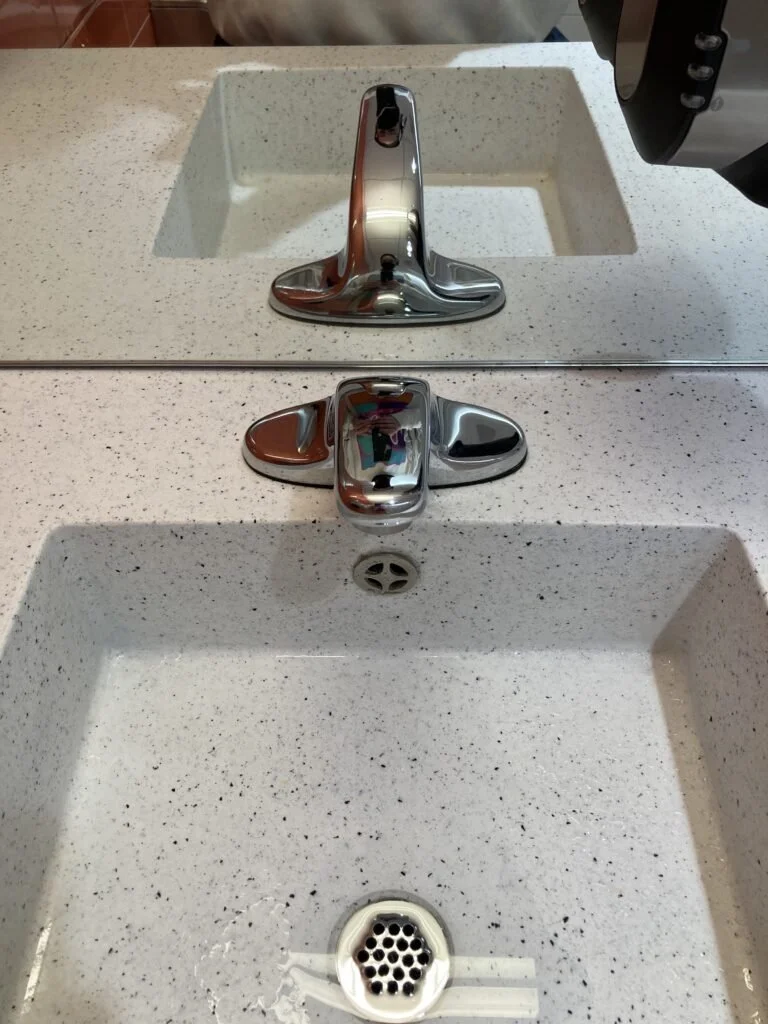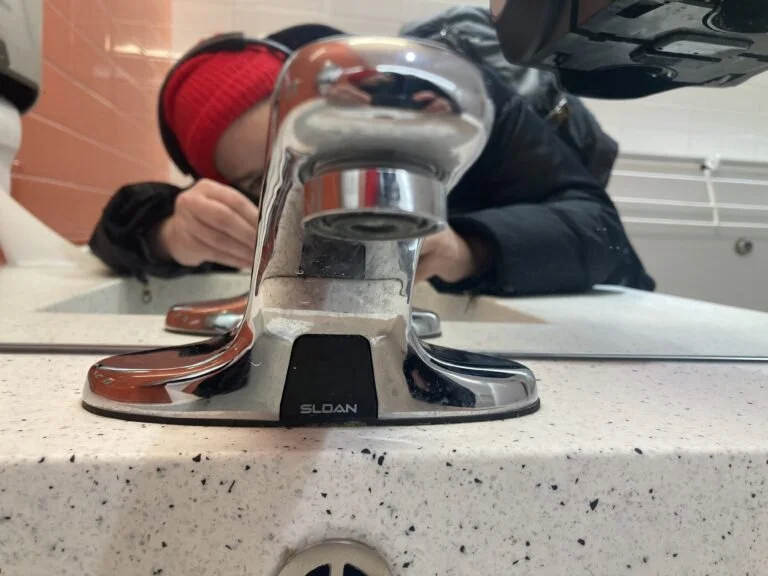Project #1: Redesigning Interaction
Team Members: Chloe Choi and Magdalena Claro
Observation and Research
For our redesigning interaction, we chose the sink in our ITP bathrooms. More specifically, the hands-free faucet. The concept behind this technology is simple: for people to clean their hands without needing an additional point of contact for germs to spread, aka the handles.
[Description of faucet goes here]
(What brand of sink, where is the sensor located, how it works)
Can we also find out if we can control the temperature?
As you can see in the images, the sensor is inserted in the “neck and base” of the faucet. If you look from the user’s perspective (from above) you don’t notice the existence or where the sensor is, you only know that it is there since you don’t see handles to turn it on or off the flow of the water. so at first, one could mistakenly assume that the sensor is above where the water comes out, pointing down.
So we start with different interactions, without first knowing what kind of sensor it is, or how it works.
Here are some videos from which you can draw the first conclusions:
Conclusions:
It does not need to recognize that it is hands to turn it on, any object can be used to start it. (hands, face, paper,…etc..).
It has a red “on” feedback light, “I found you”.
It is activated in a certain range of distance and height to the sensor. (this could lead to errors)
Quick movements don’t work well, so it’s more about presence than movement. (So it could be a proximity sensor)
When you remove the “object” (hand, fingers, etc) from the range of distance and height, the action of flowing water stops.
After having these conclusions we decided to start our online research:
First we learn that the faucet brand and type is: Sloan ETF-600/EBF-650 (OPTIMA) Faucet
And in particular that this use an infrared sensor:
“The Sloan centerset hand washing faucets operate by infrared sensor keeping sanitation and hygiene as a top priority in public restrooms. When the user enters the sensor’s effective range, the solenoid activates the water flow. Tempered water flows from the faucet until the user steps away.”
That image is from this sheet: https://www.prodryers.com/content/v/Sloan/Optima_Plus_EBF-650.pdf
ELECTRICAL SPECIFICATIONS
Battery Life: 3 years 8,000 cycles/month
Optional power harvesting significantly extends service life
Sensor Range: 4″ – 5″ (102 – 127mm)
Timeout Adjustment Settings: 30s
These images are from here: https://www.sloan.com/sites/default/files/2020-06/Sloan%20Sensors%20101%206-18-2020.pdf
Information about the Faucet and Sensor:
Here is the exact faucet site: https://www.build.com/sloan-3315025bt/s1723607?uid=4077124
Here its specification sheet: https://www.sloan.com/spec-sheet/3315025BT
And installation instructions: https://www.sloan.com/sites/default/files/2019-01/0816843Rev1_10-15-18.pdf (where you can also find TROUBLESHOOTING instructions about the sensors of possible problems.)
Ideation
As with the majority of technology, there is too much variability in every situation for every type of person for the product to work perfectly. For example, sometimes the sensors may not sense the hand because it is at a wrong distance or the act of washing hands may turn the sensing off. Other scenarios can encompass situations where you may be using the sink to wash a part of your clothes or another object. Therefore, instead of figuring out ways we can enhance the faucet to work perfectly for each scenario, we concluded that the current faucet is doing its job to the best of its ability. Instead, we will enhance the faucet by giving it an additional job; to make people wash their hands after using the bathroom.
1st iteration
After you flush the toilet the sink will turn on
The water will flow until it senses a hand
Once it senses the hands, it can then be turned off if the hands go away
2nd iteration
Having water flow continuously until the user washes their hand may result in a waste of water. Instead, we can:
Switch to sound
Sound of water running
Alarm sound
Strong wind sound
Projection of water through the projector
What is your definition of intangible interaction?
I believe that intangible interactions are those that enhance projects or products without the need for explicit human behavior. Even without the user knowing they want a certain action, a machine will produce that effect. Personally, I want to eventually harness this interaction into a feature that can be used to enhance an artwork.







